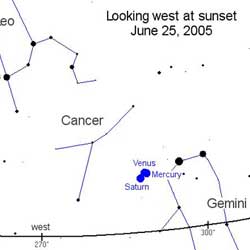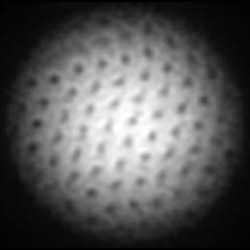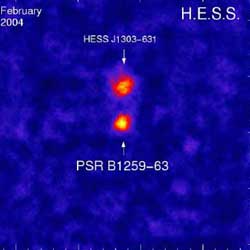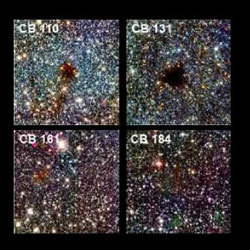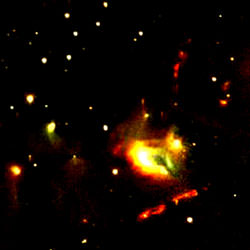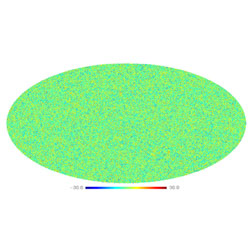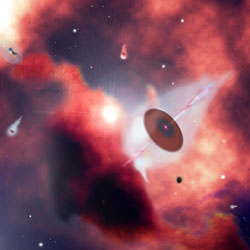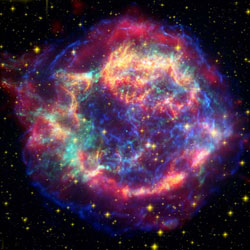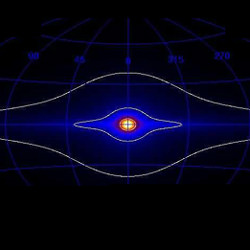
All-sky map of the best fitting ‘halo+disk’ model of 511 keV gamma-ray line emission. Image credit: INTEGRAL. Click to enlarge.
The positron, the anti-matter counterpart to the electron, was predicted by Paul Dirac’s – at the time revolutionary – quantum wave equation for the electron. A few years later, in 1932, Carl Anderson discovered the positron in cosmic rays, and Dirac got the Nobel Prize in 1933 and Anderson in 1936.
When a positron meets an electron, they annihilate, producing two gamma rays. Sometimes however, the annihilation is preceded by the formation of positronium, which is like a hydrogen atom with the proton replaced by a positron (positronium has its own symbol, Ps). Positronium comes in two forms, is unstable, and decays into either two gammas (within about 0.1 nanoseconds) or three (within about 100 nanoseconds).
Astronomers have known since the 1970s that there must be a lot of positrons in the universe. Why? Because when a positron and electron annihilate to give two gammas, both have the same wavelength, about 0.024 Å, or 0.0024 nm (astronomers, like particle physicists, don’t talk about the wavelengths of gamma rays, they talk about their energy; 511 keV in this case). So, if you look at the sky with gamma-ray vision – from above the atmosphere of course! – you know there was lots of positrons because you can see lots of gammas of a single ‘colour’, 511 keV (it’s similar to concluding there’s lots of hydrogen in the universe by noticing lots of the red (1.9 eV) H alpha in the night sky).
From the spectrum of the three-gamma decay of positronium, compared with the 511 keV line intensity, astronomers four years ago worked out that about 93% of positrons whose annihilation we see form positronium before they decay.
How much positronium? In the Milky Way bulge, about 15 billion (thousand million) tons of positrons are annihilated every second. That’s as much mass as the electrons in tens of trillions of tons of stuff we’re used to, like rocks or water; about as much as in a mid-sized asteroid, 40 km across.
By analyzing the publicly released INTEGRAL data (about one year’s worth), J?rgen Kn?dlseder and his colleagues found that:
- the positrons which are being annihilated in the Milky Way disk most likely come from the beta+ (i.e. positron) decay of the isotopes Aluminium-26 and Titanium-44, which themselves were produced in recent supernovae (remember, astronomers call even 10 million years ago ‘recent’)
- however, there are more positrons being annihilated in the Milky Way bulge than in the disk, by a factor of five
- there don’t seem to be any ‘point’ sources.
Of course, to an INTEGRAL scientist, a ‘point’ source doesn’t have quite the same meaning as it does to an amateur astronomer! Gamma-ray vision in the positronium line is incredibly blurry, an object six Moons across (3?) would look like a ‘point’! Nonetheless, Kn?dlseder and his team of astrophysics sleuths are able to say that “none of the sources we searched for showed a significant 511 keV flux”; these 40 ‘usual suspects’ include pulsars, quasars, black holes, supernovae remnants, star-forming regions, rich galaxy clusters, satellite galaxies, and blazars. But, they’re still looking, “We have indeed [planned,] dedicated INTEGRAL observations of the usual suspects, such as Type Ia supernovae (SN1006, Tycho), and LMXB (Cen X-4) which might help to solve this problem.”
So, where do the 15 billion tons of positrons being annihilated every second in the bulge come from? “For me the most important thing about the positron annihilation is that the principal source is still a mystery,” says Kn?dlseder. “We can explain the faint emission from the disk by Aluminium-26 decay, but the bulk of positrons are situated in the bulge region of the Galaxy, and we have no source that can easily explain all observational characteristics. In particular, if you compare the 511 keV sky to the sky observed at other wavelengths you recognise that the 511 keV sky is unique! There is no other sky that resembles to what we observe.”
The INTEGRAL team feel they can rule out massive stars, collapsars, pulsars, or cosmic ray interactions, for if these were the source of the bulge positrons, then the disk would be much brighter in 511 keV light.
The bulge positrons may come from low-mass X-ray binaries, classical novae, or Type 1a supernovae, through a variety of processes. The challenge in each case is to understand how sufficient positrons created by these could survive long enough afterwards and diffuse far enough from their birthplaces.
What about cosmic strings? While the recent Tanmay Vachaspati paper proposing these as a possible source of the bulge positrons came out too recently for Kn?dlseder et al. to consider for their paper, “Yet for me it is not obvious that we have enough observational constraints to state that cosmic strings make the 511 keV; we don’t even know if cosmic strings exist. One would need a unique characteristic of cosmic strings that exclude all other sources, and today I think we are far from this.”
Perhaps most excitingly, the positrons may come from the annihilation of a low-mass dark matter particle and its anti-particle, or as Kn?dlseder et al. put it “Light dark matter (1-100 MeV) annihilation, as suggested recently by Boehm et al. (2004), is probably the most exotic but also the most exciting candidate source of galactic positrons.” Dark matter is even more exotic than positronium; dark matter is not anti-matter, and no one has been able to capture it, let alone study it in a lab. Astronomers accept that it is ubiquitous and tracking down its nature is one of the hottest topics in both astrophysics and particle physics. If the billions of tons per second of positrons that are annihilated in the Milky Way bulge cannot have come from classical novae or thermonuclear supernovae, then perhaps good old dark matter is to blame.
